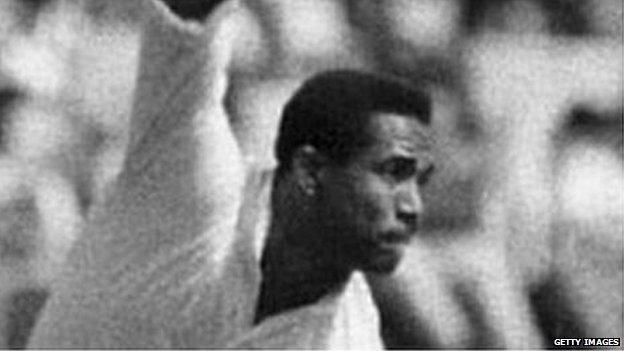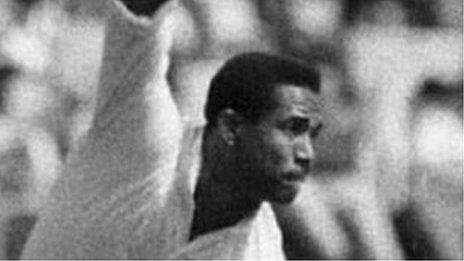St Helen's ground in Swansea to be awarded blue plaque
- Published

St Helen's was opened in 1873
It has hosted rugby and cricket internationals and witnessed one of sport's most incredible feats.
Now Swansea's St Helen's ground is to be honoured with a blue plaque by Swansea council.
It will mark the venue's contribution to sport since it first opened in 1873.
As the home of Swansea RFC, it saw famous wins against touring international teams, but it is probably as a cricket ground that St Helen's helped to make the most history.
On 31 August 1968, legendary West Indies cricketer Sir Garfield "Gary" Sobers became the first player to strike six sixes in an over, off the experimental left-arm spin of Glamorgan's Malcolm Nash.
Local legend
In 2006, the history-making ball was sold at auctioneers Christie's for £26,400, despite some doubt over whether it was definitely the right one.
According to Swansea historian Prof Peter Stead, the entire episode has become cloaked in local myth and legend.
"In its heyday St Helen's could hold more than 50,000 people, but if everyone in Swansea who claims to have been there when Gary Sobers hit six sixes is telling the truth, then there would have been well over 100,000 in there that day," he said.
"As for the ball? Well I know at least two dozen people who swear blind they have the real one.
"I wasn't there unfortunately, but I have seen some wonderful cricket and rugby at St Helen's over the years - from exquisite centuries by Clive Lloyd and Viv Richards, to the famous victory over the Wallabies."

Gary Sobers - later Sir Garfield - hit six sixes in one over, but the ball is at the centre of controversy
However, Prof Stead maintains that there is at least one six-hitting record at St Helen's which Sir Sobers cannot claim.
"As another St Helen's legend has it, during one match a six was hit out of the ground and on to a passing coal train on the heart of Wales line which used to run past the ground," he said.
"That's reputed to have ended up in Shrewsbury, so it's comfortably bigger than anything Gary Sobers managed."
Nowadays, barring the occasional visit, both the Ospreys and Glamorgan have moved on and international rugby matches are just a distant memory.
The famous east stand, which provided iconic cloisters over part of Oystermouth Road, was demolished in 2005 leaving St Helen's with a capacity of just 4,500.
But had it not been for World War Two, the story could have been very different.
Top-level sport
Damage caused by the Swansea blitz meant the council's plans to transform St Helen's into a super-stadium holding more 70,000 did not come to fruition.
"The war put pay to some of the grander schemes for St Helen's, but I do think Swansea should have fought harder to keep at least some top-level sport there," Prof Stead said.
"Cricket, and of course rugby, are in the DNA of Swansea's Welsh-speaking hinterland, and for over a century St Helen's acted as a hub to nurture that local culture."
St Helen's blue plaque will be installed close to the clubhouse steps leading to the main pavilion and will be unveiled by the start of October.
Others to be recognised under the blue plaque scheme include Dylan Thomas, Bletchley Park code breaker Vernon Watkins, singer Pete Ham and Gothic novelist Ann of Swansea.
- Published24 May 2012
